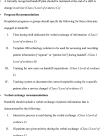Hospitalist handoffs: a systematic review and task force recommendations
- PMID: 19753573
- PMCID: PMC3575739
- DOI: 10.1002/jhm.573
Hospitalist handoffs: a systematic review and task force recommendations
Abstract
Background: Handoffs are ubiquitous to Hospital Medicine and are considered a vulnerable time for patient safety.
Purpose: To develop recommendations for hospitalist handoffs during shift change and service change.
Data sources: PubMed (through January 2007), Agency for Healthcare Research and Quality (AHRQ) Patient Safety Network, white papers, and hand search of article bibliographies.
Study selection: Controlled studies evaluating interventions to improve in-hospital handoffs (n = 10).
Data extraction: Studies were abstracted for design, setting, target, outcomes (including patient-level, staff-level, or system-level outcomes), and relevance to hospitalists.
Data synthesis: Although there were no studies of hospitalist handoffs, the existing literature from related disciplines and expert opinion support the use of a verbal handoff supplemented with written documentation in a structured format or technology solution. Technology solutions were associated with a reduction in preventable adverse events, improved satisfaction with handoff quality, and improved provider identification. Nursing studies demonstrate that supplementing verbal exchange with a written medium leads to improved retention of information. White papers characterized effective verbal exchange, as focusing on ill patients and actions required, with time for questions and minimal interruptions. In addition, content should be updated daily to ensure communication of the latest clinical information. Using this literature, recommendations for hospitalist handoffs are presented with corresponding levels of evidence. Recommendations were reviewed by hospitalists at the Society of Hospital Medicine (SHM) Annual Meeting and by an interdisciplinary team of expert consultants and were endorsed by the SHM governing board.
Conclusions: The systematic review and resulting recommendations provide hospitalists a starting point from which to improve in-hospital handoffs.
Copyright 2009 Society of Hospital Medicine.
Figures
References
-
- Solet DJ, Norvell JM, Rutan GH, Frankel RM. Lost in translation: challenges and opportunities in physician-to-physician communication during patient handoffs. Acad Med. 2005;80(12):1094–1099. - PubMed
-
- Triple Handoff, Arpana R, Vidyarthi MD. [November 22, 2008];AHRQ WebM&M [serial online] 2006 Sep; Available at http://webmm.ahrq.gov/case.aspx?caseID=134.
-
- Singh H, Thomas EJ, Petersen LA, Studdert DM. Medical errors involving trainees: a study of closed malpractice claims from 5 insurers. Arch Intern Med. 2007;167(19):2030–6. - PubMed
-
- Horwitz LI, Moin T, Krumholz HM, Wang L, Bradley EH. Consequences of inadequate sign-out for patient care. Arch Intern Med. 2008;168(16):1755–60. - PubMed
Publication types
MeSH terms
Grants and funding
LinkOut - more resources
Full Text Sources



